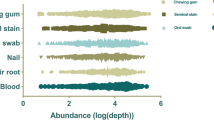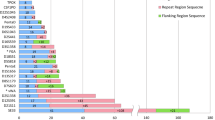Abstract
Background
Massively parallel sequencing (MPS) technology has recently been introduced in research, clinical diagnostics, and forensics. MPS enables determination of the genotypes of multiple short tandem repeat (STR) markers and to determine nucleotide sequence variations, additionally.
Objective
To improve STR analysis and a paternity index, a new, smaller-sized STR panel was designed that includes the SE33 locus.
Methods
This study performed MPS using an STR panel including the SE33 marker in 101 Koreans. The concordance study was conducted by comparing the data obtained from the MPS assay with the results of a capillary electrophoresis (CE)-based method.
Results
In this study, an in-house MPS panel is designed that incorporates the 20 Combined DNA Index System (CODIS) loci and the Penta D, Penta E, and SE33 markers for enhanced discriminatory ability. The data obtained via MPS analysis were compared with CE data to confirm concordance. Fifty previously unreported alleles were detected through the MPS analysis. Three new SNP variations in the flanking region were also identified. Statistical analysis demonstrated that the SE33 marker was most effectively determined the match probability (PM) and typical paternity index (TPI). In the sensitivity study, concentrations as low as 80 pg could be used to obtain full and concordant profiles.
Conclusions
We designed a new, smaller-sized STR panel that includes the SE33 locus to improve STR analysis and the paternity index. Various new alleles were identified in SE33, indicating a high degree of polymorphism. The panel is expected to provide valid data for discrimination of unidentified bodies.

Similar content being viewed by others

References
Al-Snan NR, Messaoudi S, Babu SR, Bakhiet M (2019) Population genetic data of the 21 autosomal STRs included in GlobalFiler kit of a population sample from the Kingdom of Bahrain. PLoS One 14:1–14. https://doi.org/10.1371/journal.pone.0220620
Ballard D, Winkler-Galicki J, Wesoły J (2020) Massive parallel sequencing in forensics: advantages, issues, technicalities, and prospects. Int J Leg Med 134:1291–1303. https://doi.org/10.1007/s00414-020-02294-0
Barbaro A, Cormaci P, La Marca A (2011) Genetic data for the locus SE33 in a Southern Italy population with AmpFlSTR NGM SElect™ PCR amplification kit. Forensic Sci Int Genet Suppl Ser 3:e101–e102. https://doi.org/10.1016/j.fsigss.2011.08.050
Barrio PA, Martín P, Alonso A, Müller P, Bodner M, Berger B, Parson W, Budowle B (2019) Massively parallel sequence data of 31 autosomal STR loci from 496 Spanish individuals revealed concordance with CE-STR technology and enhanced discrimination power. Forensic Sci Int Genet 42:49–55. https://doi.org/10.1016/j.fsigen.2019.06.009
Berglund EC, Kiialainen A, Syvänen AC (2011) Next-generation sequencing technologies and applications for human genetic history and forensics. Investig Genet 2:23. https://doi.org/10.1186/2041-2223-2-23
Bhinder MA, Zahoor MY, Sadia H, Qasim M, Perveen R, Anjum GM, Iqbal M, Ullah N, Shehzad W, Tariq M et al (2018) SE33 locus as a reliable genetic marker for forensic DNA analysis systems. Turk J Med Sci 48:611–614. https://doi.org/10.3906/sag-1801-21
Borsuk LA, Gettings KB, Steffen CR, Kiesler KM, Vallone PM (2017) Sequencing of the highly polymorphic STR locus SE33. Forensic Sci Int Genet Suppl Ser 6:e322–e323. https://doi.org/10.1016/j.fsigss.2017.09.125
Bruijns B, Tiggelaar R, Gardeniers H (2018) Massively parallel sequencing techniques for forensics: a review. Electrophoresis 39:2642–2654. https://doi.org/10.1002/elps.201800082
Butler JM, Hill CR, Kline MC, Duewer DL, Sprecher CJ, McLaren RS, Rabbach DR, Krenke BE, Storts DR (2009) The single most polymorphic STR locus: SE33 performance in U.S. populations. Forensic Sci Int Genet Suppl Ser 2:23–24. https://doi.org/10.1016/j.fsigss.2009.08.173
Churchill JD, Schmedes SE, King JL, Budowle B (2016) Evaluation of the Illumina® beta version ForenSeq™ DNA signature prep kit for use in genetic profiling. Forensic Sci Int Genet 20:20–29. https://doi.org/10.1016/j.fsigen.2015.09.009
Delest A, Godfrin D, Chantrel Y, Ulus A, Vannier J, Faivre M, Hollard C, Laurent FX (2020) Sequenced-based French population data from 169 unrelated individuals with Verogen’s ForenSeq DNA signature prep kit. Forensic Sci Int Genet 47:102304. https://doi.org/10.1016/j.fsigen.2020.102304
Gettings KB, Aponte RA, Kiesler KM, Vallone PM (2015a) The next dimension in STR sequencing: polymorphisms in flanking regions and their allelic associations. Forensic Sci Int Genet Suppl Ser 5:e121–e123. https://doi.org/10.1016/j.fsigss.2015.09.049
Gettings KB, Aponte RA, Vallone PM, Butler JM (2015b) STR allele sequence variation: current knowledge and future issues. Forensic Sci Int Genet 18:118–130. https://doi.org/10.1016/j.fsigen.2015.06.005
Gouy A, Zieger M (2017) STRAF—a convenient online tool for STR data evaluation in forensic genetics. Forensic Sci Int Genet 30:148–151
Hill CR, Duewer DL, Kline MC, Sprecher CJ, McLaren RS, Rabbach DR, Krenke BE, Ensenberger MG, Fulmer PM, Storts DR et al (2011) Concordance and population studies along with stutter and peak height ratio analysis for the PowerPlex® ESX 17 and ESI 17 systems. Forensic Sci Int Genet 5:269–275. https://doi.org/10.1016/j.fsigen.2010.03.014
Khubrani YM, Hallast P, Jobling MA, Wetton JH (2019) Massively parallel sequencing of autosomal STRs and identity-informative SNPs highlights consanguinity in Saudi Arabia. Forensic Sci Int Genet 43:102164. https://doi.org/10.1016/j.fsigen.2019.102164
Kim EH, Lee HY, Yang IS, Jung SE, Yang WI, Shin KJ (2016) Massively parallel sequencing of 17 commonly used forensic autosomal STRs and amelogenin with small amplicons. Forensic Sci Int Genet 22:1–7. https://doi.org/10.1016/j.fsigen.2016.01.001
Kim EH, Lee HY, Kwon SY, Lee EY, Yang WI, Shin KJ (2017) Sequence-based diversity of 23 autosomal STR loci in Koreans investigated using an in-house massively parallel sequencing panel. Forensic Sci Int Genet 30:134–140. https://doi.org/10.1016/j.fsigen.2017.07.001
Kim SY, Lee HC, Chung U, Ham SK, Lee HY, Park SJ, Roh YJ, Lee SH (2018) Massive parallel sequencing of short tandem repeats in the Korean population. Electrophoresis 39:2702–2707. https://doi.org/10.1002/elps.201800090
Lim S, Youn JP, Hong S, Choi D, Moon S, Kim W, Han M, Hwang SY (2017) Customized multiplexing SNP panel for Korean-specific DNA phenotyping in forensic applications. Genes Genom 39:723–732. https://doi.org/10.1007/s13258-016-0509-0
Möller A, Brinkmann B (1994) Locus ACTBP2 (SE33): sequencing data reveal considerable polymorphism. Int J Leg Med 53:262–267. https://doi.org/10.1097/00001888-197811000-00013
Park HC, Kim K, Nam Y, Park J, Lee J, Lee H, Kwon H, Jin H, Kim W, Kim W et al (2016) Population genetic study for 24 STR loci and Y indel (GlobalFiler™ PCR Amplification kit and PowerPlex® fusion system) in 1000 Korean individuals. Leg Med 21:53–57. https://doi.org/10.1016/j.legalmed.2016.06.003
Parson W, Ballard D, Budowle B, Butler JM, Gettings KB, Gill P, Gusmão L, Hares DR, Irwin JA, King JL et al (2016) Massively parallel sequencing of forensic STRs: considerations of the DNA commission of the International Society for Forensic Genetics (ISFG) on minimal nomenclature requirements. Forensic Sci Int Genet 22:54–63. https://doi.org/10.1016/j.fsigen.2016.01.009
Silvery J, Ganschow S, Wiegand P, Tiemann C (2020) Developmental validation of the monSTR identity panel, a forensic STR multiplex assay for massively parallel sequencing. Forensic Sci Int Genet 46:102236. https://doi.org/10.1016/j.fsigen.2020.102236
Souto L, Tavares F, Moreira H, Corte-Real F (2013) Evaluation of the powerplex fusion system in a sample from east timor. Forensic Sci Int Genet Suppl Ser 4:e105–e106. https://doi.org/10.1016/j.fsigss.2013.10.054
Weber-Lehmann J, Schilling E, Gradl G, Richter DC, Wiehler J, Rolf B (2014) Finding the needle in the haystack: differentiating “identical” twins in paternity testing and forensics by ultra-deep next generation sequencing. Forensic Sci Int Genet 9:42–46. https://doi.org/10.1016/j.fsigen.2013.10.015
Yang Y, Xie B, Yan J (2014) Application of next-generation sequencing technology in forensic science. Genom Proteom Bioinforma 12:190–197. https://doi.org/10.1016/j.gpb.2014.09.001
Yoo SY, An SH, Park JH, Kim NY, Lee YA, Kim JJ, Park KW, Chung KW (2014) Autosomal STR loci for improving the kinship discrimination power for missing children and forensic application. Genes Genom 36:355–363. https://doi.org/10.1007/s13258-014-0173-1
Acknowledgements
This work was supported by National Forensic Service (NFS2020DNA01), Ministry of the Interior and Safety, Republic of Korea.
Author information
Authors and Affiliations
Contributions
ESK were major contributors to the experimental design. HSK and ESK collected samples. JHL, HJK and JYK performed the MPS works. JHL and JYK were involved in writing the manuscript and data analysis and interpretation. All authors read and approved the final manuscript.
Corresponding author
Ethics declarations
Conflict of interest
Ja Hyun Lee, Jeongyong Kim, Hyojeong Kim, Hyo Sook Kim, Eungsoo Kim declare that they have no conflicts of interest.
Ethics approval and consent to participate
All procedures performed in studies involving human participants were in accordance with the ethical standards of the Institutional Review Board (IRB) of the National Forensic Service (Approval No. 906-200214-BR-011-03).
Additional information
Publisher’s note
Springer Nature remains neutral with regard to jurisdictional claims in published maps and institutional affiliations.
Ja Hyun Lee and Jeongyong Kim contributed equally to this work.
Supplementary Information
Below is the link to the electronic supplementary material.
Rights and permissions
About this article
Cite this article
Lee, J.H., Kim, J., Kim, H. et al. Massively parallel sequencing of 25 short tandem repeat loci including the SE33 marker in Koreans. Genes Genom 43, 133–140 (2021). https://doi.org/10.1007/s13258-020-01033-4
Received:
Accepted:
Published:
Issue Date:
DOI: https://doi.org/10.1007/s13258-020-01033-4



